
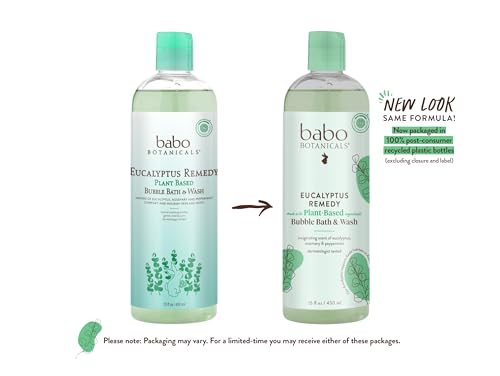
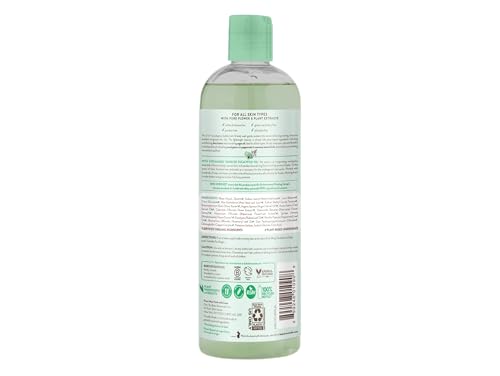
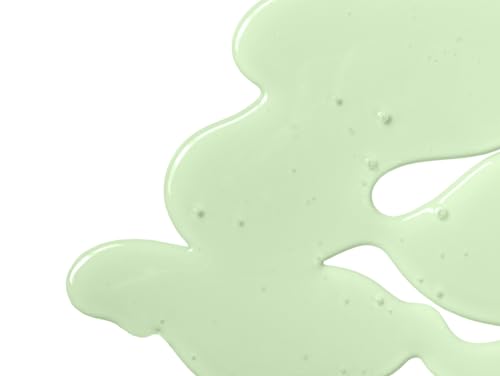
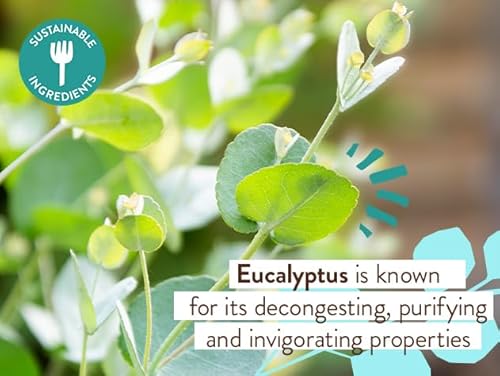
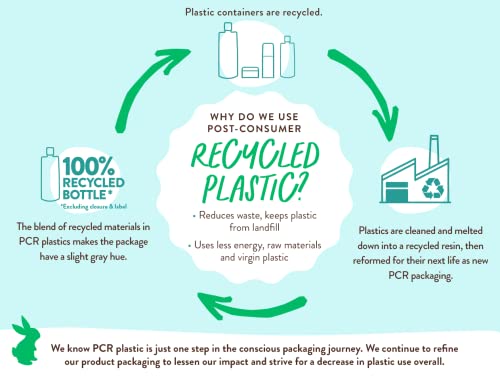
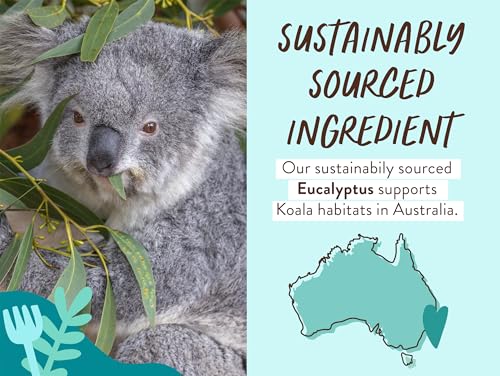


Babo Botanicals Eucalyptus Remedy Kids Shampoo & Body Wash - Soothing, EWG Verified - 8oz


Ci 75810
High RiskChlorophyllin-copper complex is obtained from chlorophyll, the green pigment in plants, and is commonly used in cosmetic and personal care products for its coloring and potential skin benefits. It serves as a stabilizer and can impart a green hue, enhancing product aesthetics.
Sustai Insights
Chlorophyllin-copper complex offers functional benefits as a colorant and stabilizer in formulations. However, its regulatory status is high-risk due to usage restrictions, and while health concerns like carcinogenicity, allergies, and reproductive toxicity are low, its potential environmental impacts, including persistence and bioaccumulation, are significant. Regulatory bodies have issued restrictions on its use, leading to an overall high-risk assessment. Safe usage practices should be observed, and alternatives like natural colorants may be considered.
Mentha Piperita (Peppermint) Oil
High RiskMentha piperita (peppermint) oil is a volatile oil extracted from the leaves of the peppermint plant, known for its strong aroma and flavor. It is commonly used in cosmetics and personal care products for its cooling properties and fragrance enhancement.
Sustai Insights
Peppermint oil offers functional benefits such as antimicrobial properties and a soothing sensation on the skin. However, it is associated with a high potential for allergies and skin irritation. Regulatory bodies impose certain restrictions on its use due to these concerns. The overall risk level is assessed as high, warranting caution in usage, especially for sensitive populations. Alternatives like spearmint oil may provide similar benefits with potentially lower irritation risks.
Rosmarinus Officinalis (Rosemary) Leaf Oil
Medium RiskRosmarinus officinalis (rosemary) leaf oil is extracted from the leaves of the rosemary plant. It is commonly used in cosmetic and personal care products for its aromatic properties and potential preservative benefits due to its antioxidant content.
Sustai Insights
Rosemary leaf oil offers functional benefits such as antimicrobial and antioxidant properties, which can enhance product stability. It is derived from a renewable source and is biodegradable. However, it presents moderate risks of allergic reactions and skin irritation, particularly with enhanced skin absorption. Regulatory bodies have noted restrictions on its usage in specific concentrations. The overall risk level is assessed as medium. Users are advised to follow safe usage practices and may consider alternatives like tocopherols or other natural preservatives.
Glycerin
Medium RiskGlycerin (also called glycerol) is a naturally occurring compound commonly used in personal care and cosmetic products. It functions as a humectant, attracting moisture to the skin, and is also utilized as a solvent and emollient to enhance product texture and stability.
Sustai Insights
Glycerin is valued for its effective moisturizing properties and biodegradability, making it a widely accepted ingredient in formulations. It poses low health risks, including low concerns for carcinogenicity and allergies. However, moderate use restrictions exist due to regulatory guidelines. While glycerin does not significantly contribute to environmental pollution, its production process should be ethically sourced. Overall, glycerin holds a medium risk level, emphasizing the importance of safe usage practices and considering sustainable alternatives.
Citric Acid
Medium RiskCitric acid is an alpha hydroxy acid used in personal care products primarily for its role as a pH adjuster and natural preservative. It occurs naturally in citrus fruits and is commonly utilized in various formulations for its chelating properties and mild exfoliation benefits.
Sustai Insights
Citric acid offers functional benefits as an effective preservative and pH stabilizer, contributing to product longevity and stability. It is biodegradable and derived from renewable sources. Health risks are low, with minimal concerns regarding carcinogenicity, allergies, and reproductive toxicity. However, moderate use restrictions exist due to potential irritation at high concentrations. Environmental risks are limited, as citric acid is not known to accumulate in ecosystems. Regulatory agencies have no significant advisories against its use. Overall, it is assessed as a medium-risk ingredient, with safe usage practices recommended and alternatives available.
Potassium Sorbate
Medium RiskPotassium sorbate is a potassium salt of sorbic acid, primarily used as a preservative in food and cosmetic products. It inhibits the growth of molds, yeast, and some bacteria, extending the shelf life of products. It is commonly found in various formulations due to its effectiveness and low toxicity.
Sustai Insights
Potassium sorbate serves as an effective preservative, preventing microbial growth in food and cosmetic products, which is vital for safety and longevity. Although it has a low risk of carcinogenicity and developmental toxicity, there is a moderate concern regarding allergies and immunotoxicity. Environmentally, it poses minimal risks as it is not significantly bioaccumulative. Regulatory agencies have verified its use, although some products may face restrictions. Overall, it is assessed as a medium risk ingredient, with safe usage practices recommended, and alternatives such as natural preservatives could be considered.
Nasturtium Officinale (Watercress) Extract
Low RiskNasturtium officinale extract is derived from the watercress plant, commonly used in skincare and cosmetic products for its potential antioxidant properties. It is included for its ability to provide moisture and support skin health.
Sustai Insights
Nasturtium officinale extract offers functional benefits such as hydration and antioxidant support, and is often sustainably sourced. Health risks are minimal, with low concerns regarding carcinogenicity, allergenic potential, and reproductive toxicity. Environmental risks are also low, as the ingredient is not associated with significant pollution or bioaccumulation. Regulatory status indicates no current restrictions. Overall, this ingredient presents a low risk profile for consumer safety and environmental impact, making it a viable option in various formulations.
Calendula Officinalis (Pot Marigold) Flower Extract
Low RiskExtract of the Calendula (Calendula officinalis) flower, commonly known as pot marigold, is utilized in cosmetic formulations for its soothing and anti-inflammatory properties. It is often included in creams, lotions, and ointments to promote skin health and healing.
Sustai Insights
Calendula officinalis flower extract offers functional benefits such as skin soothing and anti-inflammatory effects, making it valuable in topical applications. It is considered low risk for health impacts, with minimal concerns regarding carcinogenicity, allergies, or reproductive toxicity. Environmentally, it presents low pollution potential and is not bioaccumulative. Regulatory bodies have not imposed significant restrictions. Safe usage practices should be followed, and while alternatives exist, this extract is generally regarded as a low-risk option for cosmetic use.
Argania Spinosa (Argan) Kernel Oil
Low RiskArgania spinosa (argan) kernel oil is a fixed oil extracted from the kernels of the argan tree, native to Morocco. It is commonly used in cosmetic formulations for its moisturizing properties, serving as an emollient and skin conditioner.
Sustai Insights
Argania spinosa kernel oil offers functional benefits such as effective hydration and nourishment for the skin and hair. It is sustainably sourced and biodegradable, contributing positively to environmental considerations. Health risks are low, with minimal concerns regarding carcinogenicity, allergies, or reproductive toxicity. There are no current regulatory restrictions on its use. Overall, it poses low risk, making it a suitable ingredient in cosmetic products. Safe usage practices should be maintained, and alternatives like jojoba oil may also be considered for similar benefits.
Guar Hydroxypropyltrimonium Chloride
Low RiskGuar hydroxypropyltrimonium chloride is a quaternary ammonium compound derived from guar gum, primarily used as a conditioning agent in cosmetic products. It enhances the texture and feel of hair and skin formulations, providing moisture retention and improved manageability.
Sustai Insights
This ingredient offers functional benefits as a conditioning agent, improving the texture and moisture retention in formulations. It is considered low risk regarding health effects, with minimal concerns for carcinogenicity, allergies, or reproductive toxicity. Environmental risks are also low, as it does not accumulate significantly in ecosystems. Regulatory bodies have not imposed significant restrictions. Safe usage practices should be followed, but overall, this ingredient is assessed as low risk, with no immediate concerns regarding alternatives.
Chamomilla Recutita (Matricaria) Flower Extract
Low RiskChamomilla recutita (Matricaria) flower extract is derived from the flower of the chamomile plant. It is commonly used in cosmetic products for its soothing properties and as an anti-inflammatory agent. This extract is valued for its potential to calm skin irritations and enhance overall skin appearance.
Sustai Insights
Chamomilla recutita (Matricaria) flower extract is recognized for its soothing and anti-inflammatory benefits, making it effective in skincare formulations. It is sustainably sourced and not associated with significant health risks, such as carcinogenicity or allergenic potential, resulting in a low-risk profile. Environmental concerns are minimal as it does not contribute significantly to pollution. Regulatory bodies impose few restrictions on its use, further supporting its safety. However, users should practice standard safety measures, particularly if they have known sensitivities. Overall, it is a low-risk ingredient with favorable attributes.
Coco Glucoside
Low RiskCoco-glucoside is a synthetic surfactant produced from coconut oil and glucose. It serves primarily as a cleansing and emulsifying agent in personal care products, helping to create lather and improve the texture of formulations.
Sustai Insights
Coco-glucoside offers effective cleansing properties and is biodegradable, making it a more sustainable option in formulations. Health risks are generally low, with minimal concerns regarding irritation and allergies. Environmental hazards are also low, as it does not bioaccumulate. Regulatory bodies do not impose significant restrictions. Safe usage practices should be followed, and alternatives may include other mild surfactants. Overall, the risk level associated with coco-glucoside is low.
Avena Sativa (Oat) Kernel Oil
Low RiskAvena sativa (oat) kernel oil is a fixed oil extracted from the seeds of the oat plant. It is commonly used in cosmetics and skincare products for its moisturizing and nourishing properties, enhancing product texture and stability.
Sustai Insights
Avena sativa (oat) kernel oil offers functional benefits as a moisturizer and skin conditioner, with sustainability credentials due to its biodegradable nature. Health risks are low, with minimal concerns regarding carcinogenicity, allergies, or reproductive toxicity. Environmental impacts are also low, as it does not contribute significantly to pollution or bioaccumulation. Regulatory status is favorable, with no prohibitions noted. Overall, the risk level is assessed as low, making it a safe choice for cosmetic formulations.
Sodium Lauroyl Methyl Isethionate
Low RiskSodium lauroyl methyl isethionate is a surfactant and cleansing agent commonly used in cosmetic products. It is derived from natural sources and functions primarily to create lather and enhance the cleansing properties of formulations, making it effective in shampoos and body washes.
Sustai Insights
Sodium lauroyl methyl isethionate provides effective cleansing and lathering properties, making it beneficial in personal care products. It is considered biodegradable and has low allergenic potential, posing minimal health risks, including low concerns for carcinogenicity and irritation. Regulatory assessments indicate no significant restrictions, supporting its safe use. Environmental risks are minimal, with no evidence of bioaccumulation or ecotoxicity. Overall, the ingredient is assessed as low risk, with safe usage practices recommended. Alternatives include milder surfactants derived from plant sources.
Spiraea Ulmaria (Meadowsweet) Flower Extract
Low RiskSpiraea ulmaria (meadowsweet) flower extract is derived from the flowers of the Spiraea ulmaria plant. It is commonly used in cosmetic formulations for its soothing properties and is known for its role in skin care as an anti-inflammatory and astringent agent.
Sustai Insights
Meadowsweet flower extract offers functional benefits such as anti-inflammatory and astringent properties, making it useful in soothing skin formulations. It is sustainably sourced and generally recognized as safe, with low concerns regarding carcinogenicity, allergies, and reproductive toxicity. Environmental risks are minimal, as it does not contribute significantly to pollution or bioaccumulation. Regulatory bodies do not impose restrictions on its use. Overall, the ingredient presents a low risk profile, making it a viable choice in cosmetic products.
Eucalyptus Radiata Leaf/Stem Oil
Low RiskEucalyptus radiata leaf/stem oil is an essential oil derived from the leaves and stems of the eucalyptus tree. It is primarily used for its aromatic properties and potential therapeutic benefits, including antimicrobial and anti-inflammatory effects in various formulations.
Sustai Insights
Eucalyptus radiata leaf/stem oil offers functional benefits such as antimicrobial properties and pleasant fragrance, often utilized in aromatherapy and personal care products. Health risks are low, with no significant concerns regarding carcinogenicity, allergies, or reproductive toxicity. Environmentally, it does not pose notable hazards, has a low pollutant potential, and is not bioaccumulative. Regulatory agencies do not impose restrictions on its use. Overall, it is assessed as low risk, making it a suitable option in formulations, though usage should still follow recommended guidelines.
Sodium Methyl Cocoyl Taurate
Low RiskSodium methyl cocoyl taurate is a sodium salt derived from coconut fatty acids, primarily used as a mild surfactant and foaming agent in personal care products. It helps to cleanse and stabilize formulations, contributing to improved texture and performance.
Sustai Insights
Sodium methyl cocoyl taurate is recognized for its effective surfactant properties, providing gentle cleansing and foam production in formulations. It is considered low risk for health concerns such as carcinogenicity and allergenic potential, with minimal irritation noted. Environmentally, it poses low hazards with no significant bioaccumulation or pollution risks. Regulatory bodies, including ECHA, indicate no current restrictions. Overall, it presents a low risk profile, making it a viable choice in personal care applications. Safe usage practices are recommended, and alternatives may include other mild surfactants.
Coco Betaine
Low RiskCoco-betaine is a zwitterion (inner salt) derived from coconut oil, commonly used in cosmetic formulations as a surfactant and foaming agent. It helps to enhance the texture and cleansing properties of products, contributing to a mild and effective formulation suitable for various skin types.
Sustai Insights
Coco-betaine offers functional benefits as a gentle surfactant, promoting effective cleansing without excessive irritation. It is biodegradable and can be sustainably sourced from coconut oil. Health risks are considered low, with negligible concerns regarding carcinogenicity, allergies, and reproductive toxicity. Environmental risks are minimal, as it does not contribute significantly to pollution or bioaccumulation. Regulatory bodies impose low restrictions on its use, supporting its safety profile. Overall, the ingredient is assessed as low risk, making it a suitable choice in formulations.
Water
Low RiskWater is a clear, colorless liquid essential for various biological processes. It serves as a solvent in formulations, facilitating the dissolution of other ingredients and enhancing product texture and application. Additionally, water plays a crucial role in hydration and is a key component in many cosmetic and personal care products.
Sustai Insights
Water is an effective solvent and hydrator, contributing to the texture and efficacy of formulations. It is biodegradable and generally regarded as safe, with low concerns regarding carcinogenicity, allergies, and reproductive toxicity. However, excessive water usage can lead to environmental concerns, particularly regarding resource depletion. Regulatory bodies do not impose restrictions on water use in cosmetics. Overall, the risks associated with water are low, making it a safe and essential ingredient.
Sodium Chloride
Low RiskSodium chloride is an inorganic salt commonly known as table salt. It is primarily used in food preservation and flavor enhancement, as well as in various industrial applications. It exists as a crystalline solid and dissolves easily in water, making it effective for diverse uses in food products and other formulations.
Sustai Insights
Sodium chloride serves essential functions in food preservation and flavor enhancement. It is considered safe with low health risks related to cancer, allergies, and reproductive toxicity. Environmental concerns are minimal, as it does not bioaccumulate and poses low pollutant potential. Regulatory bodies, including the FDA, recognize its safety for consumption. Overall, sodium chloride carries a low risk profile, making it a widely accepted ingredient in food and cosmetic products.
Butyrospermum Parkii (Shea) Butter
Low RiskButyrospermum parkii (shea) butter is a vegetable fat derived from the nuts of the shea tree. It is commonly used in cosmetic formulations for its emollient properties, providing moisture and improving skin texture. Additionally, shea butter is known for its ability to enhance the stability of products and deliver a creamy texture.
Sustai Insights
Shea butter offers functional benefits as an effective moisturizer, enhancing skin barrier function and texture. It is sustainably sourced and biodegradable, contributing to eco-friendliness. Health-wise, it is associated with low risks for carcinogenicity, allergies, and reproductive toxicity. Environmental impacts are minimal, with no significant pollutant potential identified. Regulatory assessments indicate no current restrictions. Overall, the ingredient presents a low risk, making it a favorable choice in cosmetic formulations.
Aloe Barbadensis (Aloe Vera) Leaf Juice
Low RiskAloe barbadensis (aloe vera) leaf juice is derived from the succulent aloe vera plant, known for its hydrating and soothing properties. It is commonly used in cosmetic formulations for its moisturizing effects and is often included in products aimed at skin care and healing.
Sustai Insights
Aloe vera leaf juice offers functional benefits as a moisturizer and skin soothing agent, while being sustainably sourced and biodegradable. Health risks are low, with minimal concerns regarding carcinogenicity, allergies, and reproductive toxicity. Environmental impact is also low, with no significant pollutants identified. Regulatory agencies impose few restrictions. Overall, the ingredient poses a low risk, making it a favorable choice in cosmetic formulations.
Nasturtium Officinale (Watercress) Extract
Low RiskNasturtium officinale extract is derived from the watercress plant, commonly used in skincare and cosmetic products for its potential antioxidant properties. It is included for its ability to provide moisture and support skin health.
Sustai Insights
Nasturtium officinale extract offers functional benefits such as hydration and antioxidant support, and is often sustainably sourced. Health risks are minimal, with low concerns regarding carcinogenicity, allergenic potential, and reproductive toxicity. Environmental risks are also low, as the ingredient is not associated with significant pollution or bioaccumulation. Regulatory status indicates no current restrictions. Overall, this ingredient presents a low risk profile for consumer safety and environmental impact, making it a viable option in various formulations.
Calendula Officinalis (Pot Marigold) Flower Extract
Low RiskExtract of the Calendula (Calendula officinalis) flower, commonly known as pot marigold, is utilized in cosmetic formulations for its soothing and anti-inflammatory properties. It is often included in creams, lotions, and ointments to promote skin health and healing.
Sustai Insights
Calendula officinalis flower extract offers functional benefits such as skin soothing and anti-inflammatory effects, making it valuable in topical applications. It is considered low risk for health impacts, with minimal concerns regarding carcinogenicity, allergies, or reproductive toxicity. Environmentally, it presents low pollution potential and is not bioaccumulative. Regulatory bodies have not imposed significant restrictions. Safe usage practices should be followed, and while alternatives exist, this extract is generally regarded as a low-risk option for cosmetic use.
Argania Spinosa (Argan) Kernel Oil
Low RiskArgania spinosa (argan) kernel oil is a fixed oil extracted from the kernels of the argan tree, native to Morocco. It is commonly used in cosmetic formulations for its moisturizing properties, serving as an emollient and skin conditioner.
Sustai Insights
Argania spinosa kernel oil offers functional benefits such as effective hydration and nourishment for the skin and hair. It is sustainably sourced and biodegradable, contributing positively to environmental considerations. Health risks are low, with minimal concerns regarding carcinogenicity, allergies, or reproductive toxicity. There are no current regulatory restrictions on its use. Overall, it poses low risk, making it a suitable ingredient in cosmetic products. Safe usage practices should be maintained, and alternatives like jojoba oil may also be considered for similar benefits.
Guar Hydroxypropyltrimonium Chloride
Low RiskGuar hydroxypropyltrimonium chloride is a quaternary ammonium compound derived from guar gum, primarily used as a conditioning agent in cosmetic products. It enhances the texture and feel of hair and skin formulations, providing moisture retention and improved manageability.
Sustai Insights
This ingredient offers functional benefits as a conditioning agent, improving the texture and moisture retention in formulations. It is considered low risk regarding health effects, with minimal concerns for carcinogenicity, allergies, or reproductive toxicity. Environmental risks are also low, as it does not accumulate significantly in ecosystems. Regulatory bodies have not imposed significant restrictions. Safe usage practices should be followed, but overall, this ingredient is assessed as low risk, with no immediate concerns regarding alternatives.
Ci 75810
High RiskChlorophyllin-copper complex is obtained from chlorophyll, the green pigment in plants, and is commonly used in cosmetic and personal care products for its coloring and potential skin benefits. It serves as a stabilizer and can impart a green hue, enhancing product aesthetics.
Sustai Insights
Chlorophyllin-copper complex offers functional benefits as a colorant and stabilizer in formulations. However, its regulatory status is high-risk due to usage restrictions, and while health concerns like carcinogenicity, allergies, and reproductive toxicity are low, its potential environmental impacts, including persistence and bioaccumulation, are significant. Regulatory bodies have issued restrictions on its use, leading to an overall high-risk assessment. Safe usage practices should be observed, and alternatives like natural colorants may be considered.
Mentha Piperita (Peppermint) Oil
High RiskMentha piperita (peppermint) oil is a volatile oil extracted from the leaves of the peppermint plant, known for its strong aroma and flavor. It is commonly used in cosmetics and personal care products for its cooling properties and fragrance enhancement.
Sustai Insights
Peppermint oil offers functional benefits such as antimicrobial properties and a soothing sensation on the skin. However, it is associated with a high potential for allergies and skin irritation. Regulatory bodies impose certain restrictions on its use due to these concerns. The overall risk level is assessed as high, warranting caution in usage, especially for sensitive populations. Alternatives like spearmint oil may provide similar benefits with potentially lower irritation risks.
Chamomilla Recutita (Matricaria) Flower Extract
Low RiskChamomilla recutita (Matricaria) flower extract is derived from the flower of the chamomile plant. It is commonly used in cosmetic products for its soothing properties and as an anti-inflammatory agent. This extract is valued for its potential to calm skin irritations and enhance overall skin appearance.
Sustai Insights
Chamomilla recutita (Matricaria) flower extract is recognized for its soothing and anti-inflammatory benefits, making it effective in skincare formulations. It is sustainably sourced and not associated with significant health risks, such as carcinogenicity or allergenic potential, resulting in a low-risk profile. Environmental concerns are minimal as it does not contribute significantly to pollution. Regulatory bodies impose few restrictions on its use, further supporting its safety. However, users should practice standard safety measures, particularly if they have known sensitivities. Overall, it is a low-risk ingredient with favorable attributes.
Coco Glucoside
Low RiskCoco-glucoside is a synthetic surfactant produced from coconut oil and glucose. It serves primarily as a cleansing and emulsifying agent in personal care products, helping to create lather and improve the texture of formulations.
Sustai Insights
Coco-glucoside offers effective cleansing properties and is biodegradable, making it a more sustainable option in formulations. Health risks are generally low, with minimal concerns regarding irritation and allergies. Environmental hazards are also low, as it does not bioaccumulate. Regulatory bodies do not impose significant restrictions. Safe usage practices should be followed, and alternatives may include other mild surfactants. Overall, the risk level associated with coco-glucoside is low.
Rosmarinus Officinalis (Rosemary) Leaf Oil
Medium RiskRosmarinus officinalis (rosemary) leaf oil is extracted from the leaves of the rosemary plant. It is commonly used in cosmetic and personal care products for its aromatic properties and potential preservative benefits due to its antioxidant content.
Sustai Insights
Rosemary leaf oil offers functional benefits such as antimicrobial and antioxidant properties, which can enhance product stability. It is derived from a renewable source and is biodegradable. However, it presents moderate risks of allergic reactions and skin irritation, particularly with enhanced skin absorption. Regulatory bodies have noted restrictions on its usage in specific concentrations. The overall risk level is assessed as medium. Users are advised to follow safe usage practices and may consider alternatives like tocopherols or other natural preservatives.
Avena Sativa (Oat) Kernel Oil
Low RiskAvena sativa (oat) kernel oil is a fixed oil extracted from the seeds of the oat plant. It is commonly used in cosmetics and skincare products for its moisturizing and nourishing properties, enhancing product texture and stability.
Sustai Insights
Avena sativa (oat) kernel oil offers functional benefits as a moisturizer and skin conditioner, with sustainability credentials due to its biodegradable nature. Health risks are low, with minimal concerns regarding carcinogenicity, allergies, or reproductive toxicity. Environmental impacts are also low, as it does not contribute significantly to pollution or bioaccumulation. Regulatory status is favorable, with no prohibitions noted. Overall, the risk level is assessed as low, making it a safe choice for cosmetic formulations.
Sodium Lauroyl Methyl Isethionate
Low RiskSodium lauroyl methyl isethionate is a surfactant and cleansing agent commonly used in cosmetic products. It is derived from natural sources and functions primarily to create lather and enhance the cleansing properties of formulations, making it effective in shampoos and body washes.
Sustai Insights
Sodium lauroyl methyl isethionate provides effective cleansing and lathering properties, making it beneficial in personal care products. It is considered biodegradable and has low allergenic potential, posing minimal health risks, including low concerns for carcinogenicity and irritation. Regulatory assessments indicate no significant restrictions, supporting its safe use. Environmental risks are minimal, with no evidence of bioaccumulation or ecotoxicity. Overall, the ingredient is assessed as low risk, with safe usage practices recommended. Alternatives include milder surfactants derived from plant sources.
Spiraea Ulmaria (Meadowsweet) Flower Extract
Low RiskSpiraea ulmaria (meadowsweet) flower extract is derived from the flowers of the Spiraea ulmaria plant. It is commonly used in cosmetic formulations for its soothing properties and is known for its role in skin care as an anti-inflammatory and astringent agent.
Sustai Insights
Meadowsweet flower extract offers functional benefits such as anti-inflammatory and astringent properties, making it useful in soothing skin formulations. It is sustainably sourced and generally recognized as safe, with low concerns regarding carcinogenicity, allergies, and reproductive toxicity. Environmental risks are minimal, as it does not contribute significantly to pollution or bioaccumulation. Regulatory bodies do not impose restrictions on its use. Overall, the ingredient presents a low risk profile, making it a viable choice in cosmetic products.
Eucalyptus Radiata Leaf/Stem Oil
Low RiskEucalyptus radiata leaf/stem oil is an essential oil derived from the leaves and stems of the eucalyptus tree. It is primarily used for its aromatic properties and potential therapeutic benefits, including antimicrobial and anti-inflammatory effects in various formulations.
Sustai Insights
Eucalyptus radiata leaf/stem oil offers functional benefits such as antimicrobial properties and pleasant fragrance, often utilized in aromatherapy and personal care products. Health risks are low, with no significant concerns regarding carcinogenicity, allergies, or reproductive toxicity. Environmentally, it does not pose notable hazards, has a low pollutant potential, and is not bioaccumulative. Regulatory agencies do not impose restrictions on its use. Overall, it is assessed as low risk, making it a suitable option in formulations, though usage should still follow recommended guidelines.
Sodium Methyl Cocoyl Taurate
Low RiskSodium methyl cocoyl taurate is a sodium salt derived from coconut fatty acids, primarily used as a mild surfactant and foaming agent in personal care products. It helps to cleanse and stabilize formulations, contributing to improved texture and performance.
Sustai Insights
Sodium methyl cocoyl taurate is recognized for its effective surfactant properties, providing gentle cleansing and foam production in formulations. It is considered low risk for health concerns such as carcinogenicity and allergenic potential, with minimal irritation noted. Environmentally, it poses low hazards with no significant bioaccumulation or pollution risks. Regulatory bodies, including ECHA, indicate no current restrictions. Overall, it presents a low risk profile, making it a viable choice in personal care applications. Safe usage practices are recommended, and alternatives may include other mild surfactants.
Coco Betaine
Low RiskCoco-betaine is a zwitterion (inner salt) derived from coconut oil, commonly used in cosmetic formulations as a surfactant and foaming agent. It helps to enhance the texture and cleansing properties of products, contributing to a mild and effective formulation suitable for various skin types.
Sustai Insights
Coco-betaine offers functional benefits as a gentle surfactant, promoting effective cleansing without excessive irritation. It is biodegradable and can be sustainably sourced from coconut oil. Health risks are considered low, with negligible concerns regarding carcinogenicity, allergies, and reproductive toxicity. Environmental risks are minimal, as it does not contribute significantly to pollution or bioaccumulation. Regulatory bodies impose low restrictions on its use, supporting its safety profile. Overall, the ingredient is assessed as low risk, making it a suitable choice in formulations.
Water
Low RiskWater is a clear, colorless liquid essential for various biological processes. It serves as a solvent in formulations, facilitating the dissolution of other ingredients and enhancing product texture and application. Additionally, water plays a crucial role in hydration and is a key component in many cosmetic and personal care products.
Sustai Insights
Water is an effective solvent and hydrator, contributing to the texture and efficacy of formulations. It is biodegradable and generally regarded as safe, with low concerns regarding carcinogenicity, allergies, and reproductive toxicity. However, excessive water usage can lead to environmental concerns, particularly regarding resource depletion. Regulatory bodies do not impose restrictions on water use in cosmetics. Overall, the risks associated with water are low, making it a safe and essential ingredient.
Glycerin
Medium RiskGlycerin (also called glycerol) is a naturally occurring compound commonly used in personal care and cosmetic products. It functions as a humectant, attracting moisture to the skin, and is also utilized as a solvent and emollient to enhance product texture and stability.
Sustai Insights
Glycerin is valued for its effective moisturizing properties and biodegradability, making it a widely accepted ingredient in formulations. It poses low health risks, including low concerns for carcinogenicity and allergies. However, moderate use restrictions exist due to regulatory guidelines. While glycerin does not significantly contribute to environmental pollution, its production process should be ethically sourced. Overall, glycerin holds a medium risk level, emphasizing the importance of safe usage practices and considering sustainable alternatives.
Citric Acid
Medium RiskCitric acid is an alpha hydroxy acid used in personal care products primarily for its role as a pH adjuster and natural preservative. It occurs naturally in citrus fruits and is commonly utilized in various formulations for its chelating properties and mild exfoliation benefits.
Sustai Insights
Citric acid offers functional benefits as an effective preservative and pH stabilizer, contributing to product longevity and stability. It is biodegradable and derived from renewable sources. Health risks are low, with minimal concerns regarding carcinogenicity, allergies, and reproductive toxicity. However, moderate use restrictions exist due to potential irritation at high concentrations. Environmental risks are limited, as citric acid is not known to accumulate in ecosystems. Regulatory agencies have no significant advisories against its use. Overall, it is assessed as a medium-risk ingredient, with safe usage practices recommended and alternatives available.
Sodium Chloride
Low RiskSodium chloride is an inorganic salt commonly known as table salt. It is primarily used in food preservation and flavor enhancement, as well as in various industrial applications. It exists as a crystalline solid and dissolves easily in water, making it effective for diverse uses in food products and other formulations.
Sustai Insights
Sodium chloride serves essential functions in food preservation and flavor enhancement. It is considered safe with low health risks related to cancer, allergies, and reproductive toxicity. Environmental concerns are minimal, as it does not bioaccumulate and poses low pollutant potential. Regulatory bodies, including the FDA, recognize its safety for consumption. Overall, sodium chloride carries a low risk profile, making it a widely accepted ingredient in food and cosmetic products.
Potassium Sorbate
Medium RiskPotassium sorbate is a potassium salt of sorbic acid, primarily used as a preservative in food and cosmetic products. It inhibits the growth of molds, yeast, and some bacteria, extending the shelf life of products. It is commonly found in various formulations due to its effectiveness and low toxicity.
Sustai Insights
Potassium sorbate serves as an effective preservative, preventing microbial growth in food and cosmetic products, which is vital for safety and longevity. Although it has a low risk of carcinogenicity and developmental toxicity, there is a moderate concern regarding allergies and immunotoxicity. Environmentally, it poses minimal risks as it is not significantly bioaccumulative. Regulatory agencies have verified its use, although some products may face restrictions. Overall, it is assessed as a medium risk ingredient, with safe usage practices recommended, and alternatives such as natural preservatives could be considered.
Butyrospermum Parkii (Shea) Butter
Low RiskButyrospermum parkii (shea) butter is a vegetable fat derived from the nuts of the shea tree. It is commonly used in cosmetic formulations for its emollient properties, providing moisture and improving skin texture. Additionally, shea butter is known for its ability to enhance the stability of products and deliver a creamy texture.
Sustai Insights
Shea butter offers functional benefits as an effective moisturizer, enhancing skin barrier function and texture. It is sustainably sourced and biodegradable, contributing to eco-friendliness. Health-wise, it is associated with low risks for carcinogenicity, allergies, and reproductive toxicity. Environmental impacts are minimal, with no significant pollutant potential identified. Regulatory assessments indicate no current restrictions. Overall, the ingredient presents a low risk, making it a favorable choice in cosmetic formulations.
Aloe Barbadensis (Aloe Vera) Leaf Juice
Low RiskAloe barbadensis (aloe vera) leaf juice is derived from the succulent aloe vera plant, known for its hydrating and soothing properties. It is commonly used in cosmetic formulations for its moisturizing effects and is often included in products aimed at skin care and healing.
Sustai Insights
Aloe vera leaf juice offers functional benefits as a moisturizer and skin soothing agent, while being sustainably sourced and biodegradable. Health risks are low, with minimal concerns regarding carcinogenicity, allergies, and reproductive toxicity. Environmental impact is also low, with no significant pollutants identified. Regulatory agencies impose few restrictions. Overall, the ingredient poses a low risk, making it a favorable choice in cosmetic formulations.
Discover the soothing benefits of Babo Botanicals Eucalyptus Remedy 2-in-1 Bubble Bath & Wash, perfect for your little one's delicate skin. This gentle formula combines invigorating eucalyptus, calming lavender, and refreshing rosemary to create a nourishing bath experience for all ages.
- Gentle Cleansing: This 2-in-1 shampoo and body wash gently cleans while providing plant-based bubbles safe for newborns.
- Soothing Aromatherapy: Infused with eucalyptus, it promotes relaxation, helping facilitate restful sleep for sensitive skin.
- Hypoallergenic Formula: Made with naturally-derived ingredients, free from harsh chemicals, gluten, soy, and dairy, ensuring safety for all skin types.
- EWG Verified & Organic: Featuring USDA Certified Organic ingredients and B Corp Certified practices, this product is both safe and eco-friendly.
- Versatile Use: Ideal for bath time or shower, simply mix into running water for bubbles or apply directly for a calming cleanse.
Subscribe & Save with Sustai
- Best Price Guarantee: Always enjoy the lowest prices on sustainable home essentials.
- No Surprises: We’ll notify you before shipping. No hidden fees, ever.
- You’re in Charge: Change, pause, or cancel your subscription anytime with ease.
- Eco-Friendly Deliveries: Our grouped shipments mean less packaging and lower emissions.
Join us on a sustainable journey. Special offers for a limited time! Prices and promotions may change.
Recommended Products
Discover the soothing benefits of Babo Botanicals Eucalyptus Remedy 2-in-1 Bubble Bath & Wash, perfect for your little one's delicate skin. This gentle formula combines invigorating eucalyptus, calming lavender, and refreshing rosemary to create a nourishing bath experience for all ages.
- Gentle Cleansing: This 2-in-1 shampoo and body wash gently cleans while providing plant-based bubbles safe for newborns.
- Soothing Aromatherapy: Infused with eucalyptus, it promotes relaxation, helping facilitate restful sleep for sensitive skin.
- Hypoallergenic Formula: Made with naturally-derived ingredients, free from harsh chemicals, gluten, soy, and dairy, ensuring safety for all skin types.
- EWG Verified & Organic: Featuring USDA Certified Organic ingredients and B Corp Certified practices, this product is both safe and eco-friendly.
- Versatile Use: Ideal for bath time or shower, simply mix into running water for bubbles or apply directly for a calming cleanse.

You can have at most 2 Sustainable Steals products in your cart
Customer Reviews
Customers’ View
Customers appreciate the gentle and effective nature of the 2-in-1 Bubble Bath & Wash, highlighting its suitability for sensitive skin. Many reviews commend the product's pleasant eucalyptus scent, describing it as refreshing without being overpowering. Users also note the high-quality bubbles that provide a soothing bath experience for children, with several mentioning that it does not dry out the skin. The moisturizing properties are frequently praised, with customers expressing satisfaction that their skin feels nourished rather than irritated. Additionally, the product's EWG verification and plant-based ingredients resonate positively with health-conscious consumers, reinforcing their trust in its safety and eco-friendliness. Overall, customers find this product to be a reliable choice for bath time, aligning well with their values of sustainability and gentle care.
AI-generated from the text of customer reviewsThis product is rated 5.0 of 5.0 stars.
It has received 4 reviews.




